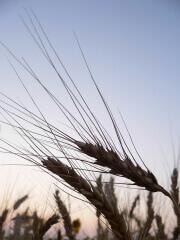 When cereals like wheat and barley germinate or sprout, α-amylase will form. Rainy, adverse weather conditions during harvest can cause sprouting. If badly sprouted grain is milled, the flour can cause product problems such as sticky, doughy bread or noodles which are too stretchy. The same goes for malting; if the barley has pre-germinated in the field it has a decreased ability to germinate during the malting process. Even barley with a low degree of pre-germination is affected as the ability to germinate further decreases during storage. This not possible to detect through visual inspection and α-amylase testing is therefore required.
When cereals like wheat and barley germinate or sprout, α-amylase will form. Rainy, adverse weather conditions during harvest can cause sprouting. If badly sprouted grain is milled, the flour can cause product problems such as sticky, doughy bread or noodles which are too stretchy. The same goes for malting; if the barley has pre-germinated in the field it has a decreased ability to germinate during the malting process. Even barley with a low degree of pre-germination is affected as the ability to germinate further decreases during storage. This not possible to detect through visual inspection and α-amylase testing is therefore required.
The dominating method is a test called the Falling number method. It is used to measure the effect of the α-amylase accurately. The time in seconds for a plunger to fall to the bottom of a glass tube filled with a heated paste of wheat meal and water is known as the falling number. The amylograph test is very similar to the falling number method but the analyser measures viscosity while increasing temperature.
However, these methods are slow and when large numbers of assays must be performed, other methods are more suitable and accurate. Phadebas Amylase Test has been used for this purpose for many years. The Phadebas method was evaluated by Barnes and Blakeney* and demonstrated a good correlation with Falling Number and Amylograph methods. Today many customers within the milling industry appreciate the precision and simplicity offered by Phadebas Amylase Test. The major segments are producers of starch from various origins, malt suppliers and breweries, bakeries and feed producers.
* Determination of Cereal Alpha Amylase Uding a Commercially Available Dye-labelled Substrate, W.C. Barnes, A.B. Blakeney
